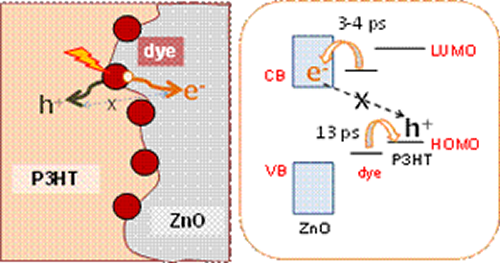June 2014 Issue
Research Highlights
Hybrid solar cells: The Mechanism of dyeing for greater efficiency
Light-harvesting organic materials have the potential to provide low cost electricity through solar power. However, current designs for organic-inorganic hybrid solar cells (OIHSCs) suffer weaknesses at the interface between organic and inorganic components and this limits efficiency.
Now, Qing Shen at the University of Electro-Communications, Tokyo, and Shuzi Hayase at Kyushu Institute of Technology together with scientists in Hayase JST CREST Research Team across Japan, have succeeded in clarifying the mechanism for improving the performance of an OIHSC by adding a dye sensitizer directly onto the organic-inorganic interface.
When sunlight hits the organic donor material in an OIHSC, excitons are generated (an electrically-neutral state where electron and hole are bound together) and begin to move around. At the interface, the excitons split into electrons in the inorganic acceptor material and holes in the organic donor material. This charge separation allows a current to flow.
Problems with efficiency occur when, instead of remaining separate, the electrons and holes recombine at the interface, slowing down the electricity production.
Shen , Hayase and co-workers in Hayase JST CREST Research Team used an OIHSC made from a film of poly(3-hexylthiophene) (P3HT), a common organic donor material, and an inorganic acceptor made from zinc oxide (ZnO). They studied charge separation and recombination processes at the interfaces using time-resolved laser spectroscopy, namely, transient absorption (TA) technique. They found that when they added dye to the OIHSC interface, the molecules in the dye helped separate the holes in P3HT from the electrons in ZnO. A reduction in ZnO surface states as a result of dye-sensitizing also led to the decrease in electron trapping, helping to minimize the chances of charge recombination.
Overall, the research team found a methodology to design a high-performing OIHSC that provided rapid charge separation, while greatly suppressing charge recombination.
Publication and Affiliation
Qing Shen*ab, Yuhei Ogomibc, Sandeep K.Dasc, Shyam S.Pandeybc, Kenji Yoshinobd, Kenji Katayamae , Hisayo Momosef, Taro Toyodaab, & Shuzi Hayase*bc. Huge suppression of charge recombination in P3HT-ZnO organic-inorganic hybrid solar cells by locating dyes at the ZnO/P3HT interfaces. PCCP (2013)
- Department of Engineering Science, Faculty of Informatics and Engineering,
The University of Electro-Communications, 1-5-1 Chofugaoka, Chofu,
Tokyo 182-8585, Japan - CREST, Japan Science and Technology Agency (JST), 4-1-8 Honcho, Kawaguchi,
Saitama 332-0012, Japan - Graduate School of Life Science and Systems Engineering, Kyushu Institute of
Technology, 2-4 Hibikino, Wakamatsu, Kitakyushu 808-0196, Japan - Department of Electrical and Electronic Engineering, Miyazaki University,
1-1 Gakuen kibanadai-nishi, Miyazaki 889-2192, Japan - Department of Applied Chemistry, Faculty of Science and Engineering,
Chuo University, 1-13-27 Kasuga, Bunkyo, Tokyo 112-8551, Japan - Center For Semiconductor Research & Development, Toshiba corporation,
580-1 Horikawa-cho, Saiwai-ku, Kawasaki-shi, Kanagawa 212-8520, Japan
*corresponding author, e-mail address:;



